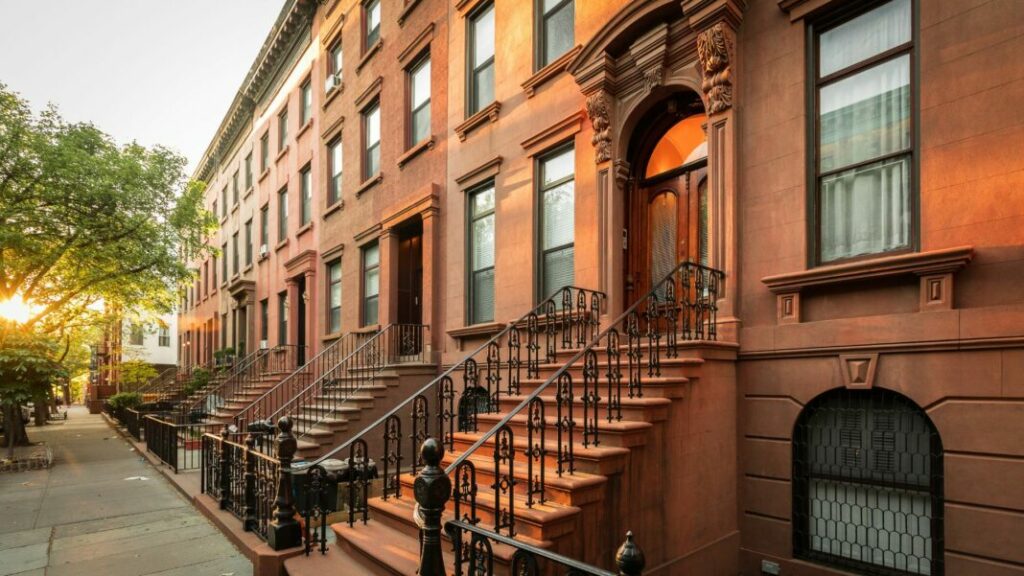
Walking the streets of New York City can help you feel like you’ve stepped back in time. Certain neighborhoods have historic structures and mature trees, including brownstone homes. Although that term gets thrown around a lot, not everyone knows what a brownstone is or where it got its name. Explore the answer to the question, what is a brownstone, to better understand the meaning of this term and why it’s used to refer to homes in certain places.
What is a brownstone?
The term brownstone refers to a specific type of row house or townhouse built in New York City during the 19th century. The word refers to the brown sandstone that coats the facade of these homes, which often came from the Portland Brownstone Quarry located in nearby Connecticut. The material traveled down the Connecticut and Hudson rivers on barges to New York, where it was then applied to the exteriors of row homes built for middle-class families during this time.
Brown sandstone was affordable at the time, and it was easy to carve and cut with machines powered by steam. As a result, it was a commonly used material in both residential and commercial real estate throughout New York City. It includes various types of rock, although its main component is cemented quartz grains.
In order to qualify as a true brownstone, a home must have brown sandstone on its exterior and a grand stoop, or a porch that sits above the ground level. The purpose of this requirement was to elevate the home above the streets, which were far less clean and hygienic during the 19th century. This portion of the home is known as the parlor floor. Some brownstones in the city also feature rounded nooks or bay windows, and most are approximately three to four floors in height.
Brownstone vs. townhouse
A townhouse is a row-style house that typically has at least two floors. Some people use the terms “brownstone” and “townhouse” interchangeably, but they aren’t exactly the same. A brownstone might qualify as a townhouse if it is part of a row, connected to the other homes in the row, and features the brown sandstone on its exterior. Some townhomes are historic, while others are brand-new.
Another key difference between a brownstone and a townhouse is that a brownstone might be split into multiple units, while the entire townhouse is a single living unit. If you want more space, living in a townhouse might be more appealing as you could end up with access to multiple floors.
Brownstones in popular culture
Even if you haven’t walked the streets of Manhattan yourself, you’ve probably seen at least one brownstone on the big screen. In “Do the Right Thing,” a popular film directed by Spike Lee, Mookie lived in an iconic brownstone. On the silver screen, writer Carrie Bradshaw lived in a brownstone located in the West Village on “Sex and the City.” Currently, most of the brownstones remaining in New York are seen on the Upper West Side and Harlem. Brooklyn houses brownstones in its Park Slope, Brooklyn Heights, Carroll Gardens, Bed Stuy, and Fort Greene neighborhoods.
Pros of living in a brownstone
Living in a brownstone does come with some advantages, as long as it’s been properly cared for over the years. This style of home is the quintessential living environment for many New Yorkers, and one that others may aspire to call home. If you like the idea of sitting on your stoop and chatting with neighbors, you’ll have plenty of space on the grand stoop of a brownstone. Although some building owners have split brownstones into multiple units, most renters in these structures have the entire floor to themselves. Some NYC brownstones even span multiple floors.
When brownstones were originally built, they were designed as single-family residences. The designers and builders often took the needs of families into account, adding small outdoor spaces for residents to enjoy. Many of the units available still offer access to outdoor spaces, including small yards and patios. In a city like New York, outdoor space is not easy to find, so this is certainly a perk.
The historic charm of these homes also includes ornate details both inside and out. A brownstone might feature original hardwood flooring, stained glass windows, or carved wooden elements throughout. If you prefer a unit that doesn’t look exactly like all the other units on the street, a brownstone will certainly appeal to you.
Cons of living in a brownstone
As mentioned, a brownstone gets its name from the material used to coat the exterior and create a particular look. However, it’s helpful to note that the construction of these homes primarily took place in the 19th century, and some of the materials used have deteriorated. Living in a brownstone might not be as appealing if its walls are crumbling or its ceiling is falling down. However, most landlords address these potential issues and restore the properties for which they maintain responsibility.
If walking up the front stairs on the regular isn’t appealing or physically feasible, you may want to consider a different style of home, as brownstones are nearly always walk-ups. You may end up paying more to live in a brownstone because of the appeal and charm, which drives up the price. If a brownstone hasn’t been updated, you might also have to do without certain modern amenities, such as central air conditioning or in-unit laundry. But many people in New York use window-mounted air conditioning units and public laundry facilities, so this may not be a significant drawback for you.
If you’re dying to live in a brownstone in New York City, use Zumper to make that happen. The search functionality makes it easy to filter certain results and find exactly what you’re looking for in your next living space.



